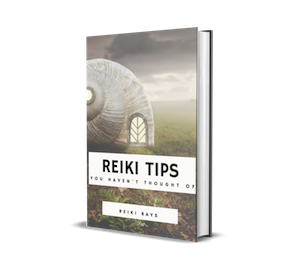Article by Angie Webster
The first of the Reiki principles is usually worded, “Just for today, I will not anger.” This is frequently taken in a somewhat dogmatic way, as a command or an order of what we are not to feel. That is a misperception.
Anger is a human emotion. Like all emotions, it is an energy. Each emotional energy has its own energy signature, like a frequency. You might think of emotions like weather conditions outdoors. Only with our emotions, the weather is inside our bodies, where we experience every wind gust, thunder bolt or warm ray of sunshine.
Using this analogy, you could think of sadness as a rainstorm on a gloomy day, or fear as dense fog on a dark night, happiness as a warm, sunny spring morning and anger as a loud, windy thunderstorm as you roll across the waves on the sea. But like all weather, the energy passes eventually. Depending upon the path the weather takes and the manner in which it is interacted with, it may leave behind some damage or some fond memories, but it will always pass.
With emotions, there is almost always an interaction between our minds and the emotional energy in the form of thoughts or the stories we tell ourselves about the emotion we are feeling. We tell ourselves it is good or bad to feel this way, that we should or should not be experiencing this, that someone “made” us feel this, or that things shouldn’t be the way they are. The interaction of thought with emotion holds the energy in our body, keeping it from moving through.
We can even feed the energy with our thoughts, making it grow larger, by telling ourselves that it is important to feel this way or that it is “justified”. We probably do this most often with anger and worry or anxiety, as these are very intense emotional energies to find our way out of. The stories that we tell ourselves can become very convincing and reinforcing.
The main purpose of the principle that speaks of anger is not to chastise us for feeling a human emotion, but to point to this danger of getting entangled in the interaction between our thoughts and the emotional energy of anger. When we allow our thoughts to be in control of the energy, it will only build in intensity and destruction and it will take a long time to dissipate. Harm is very likely to occur to you and others, on at least an energetic level.

Image by Unsplash
When we are conscious of the interaction of our thoughts with our emotions, we can make the choice to do something different by opting to pay attention to the process and seek balance. This takes practice, but in working with it, you begin to find that anger becomes a teacher and a guide. It is still not a pleasant emotion and it feels like being tossed in a storm, but I find I learn more about how to work with energy every time I experience it. Anger can even be a creative energy, when it is applied well and in a balanced way.
If the energy of anger is flowing through you very intensely and you are feeling as though it’s difficult to navigate, find a brief activity that will be calming and distracting for a minute or two, preferably something that works your body in some way. This will help to ground you and to take you out of any thought process or story line you are actively engaged in about your emotional energy. You could do a short breathing exercise or walking meditation or clean something. Whatever works for you.
After you have found a small bit of space in your thought process, sit down and get still, but don’t allow yourself to get involved in the thought process again. Focus on your breathing, starting by focusing on the breath moving in an out of the belly and on the sensations you feel in your body. You may want to scan your attention over many areas of your body. As your attention wanders or drifts back into thoughts about how you are feeling, gently bring your attention back to your belly breathing and then to the sensations in your body. Allow yourself to feel any sensation or emotion that arises. Don’t push away any thought that comes forward, but also don’t actively engage with it. Think of the thoughts that arise as interesting strangers that are walking past you outside your window. Observe them with interest, but don’t interact with them.
As you do this for several minutes, you will begin to notice that the uncomfortable feelings that you had in your body when you began have begun to fade away and you feel more balanced. You will notice that you have more of a feeling of openness and expansiveness. Thoughts that arise will have less to do with supporting stories of anger. They may be more related to forgiveness or they may be related to other things entirely. Solutions may spring to mind that were blocked from you before.
When you find yourself experiencing the emotion of anger, consider that it may be a teacher and a tool. Be kind to yourself. Anger is difficult to experience and to navigate, so have self-compassion. Don’t try to push the anger energy away, but accept that you are having this energy. Acceptance is not the same thing as resignation. It does not mean that you give up and choose not to do anything useful. Consciously make an effort to choose not to engage in the damaging interaction between the emotional energy and the thought process or storyline and you will find balance.
Free eBook download: We’ve created an eBook with our best articles on this topic, and offer it for free to all our newsletter subscribers.


Angie Webster
Angie Webster is a Reiki Master, Teacher, and Author. Angie’s primary focus is animal Reiki, which she adores. She teaches online Reiki Level One, Animal Reiki, flower essences, and various personal growth courses.
Angie is the author of “Animal Reiki: How it Heals, Teaches & Reconnects Us with Nature” and “Reiki from A to Z”. You can follow her at: https://angie-webster-school-of-reiki.teachable.com





Leave a Reply